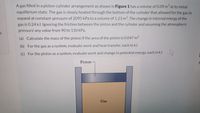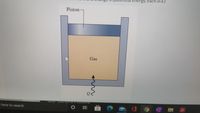
Elements Of Electromagnetics
7th Edition
ISBN: 9780190698614
Author: Sadiku, Matthew N. O.
Publisher: Oxford University Press
expand_more
expand_more
format_list_bulleted
Concept explainers
Question

Transcribed Image Text:A gas filled in a piston-cylinder arrangement as shown in Figure 1 has a volume of 0.09 m³ at its initial
equilibrium state. The gas is slowly heated through the bottom of the cylinder that allowed for the gas to
expand at constant-pressure of 2095 kPa to a volume of 1.23 m°. The change in internal energy of the
gas is 0.24 kJ. Ignoring the friction between the piston and the cylinder and assuming the atmospheric
pressure any value from 90 to 110 kPa,
of
(a) Calculate the mass of the piston if the area of the piston is 0.047 m2
(b) For the gas as a system, evaluate work and heat transfer, each in kJ
(c) For the piston as a system, evaluate work and change in potential energy, each in kJ
Piston
Gas

Transcribed Image Text:energy, each in kJ
Piston-
Gas
e here to search
Expert Solution
This question has been solved!
Explore an expertly crafted, step-by-step solution for a thorough understanding of key concepts.
This is a popular solution
Trending nowThis is a popular solution!
Step by stepSolved in 2 steps with 1 images

Knowledge Booster
Learn more about
Need a deep-dive on the concept behind this application? Look no further. Learn more about this topic, mechanical-engineering and related others by exploring similar questions and additional content below.Similar questions
- 3-54 A piston-cylinder contains 0.005 m³ of liquid water and 0.9 m³ of water vapor in equilibrium at 600 kPa. Heat is transferred at a constant pressure until the temperature reaches 200°C. (a) What is the initial temperature of the water? (b) Determine the total mass of the water. (c) Calculate the final volume. (d) Show the process on a P-v diagram with respect to saturation lines.arrow_forward4-65E A 10 ft³ tank contains oxygen initially at 14.7 psia and 80°F. A paddle wheel within the tank is rotated until the pressure inside rises to 20 psia. During the process 20 Btu of heat is lost to the surroundings. Determine the paddle-wheel work done. Neglect the energy stored in the paddle wheel.arrow_forwardA gas is compressed inside a compressor’s cylinder. Whenthe piston is at its bottom dead center, the gas is initiallyat 10 psig, 65°F, and 10.5 in3. After compression andwhen the piston is at top dead center, the gas is 180°Fand occupies 1.5 in3. What would be the new pressure ofthe gas in psig?arrow_forward
- A piston-cylinder device contains an ideal gas of nitrogen. At the initial state, the volume is V1= 1.00 m3, the pressure is p1= 400.00 kPa, the temperature is T1= 300.00 K. An electric heater within the device is turned on for a time of Δt = 5.00 min. The current is I = 3.00 A, and the source voltage is V = 120.00 V. During the heating process, the gas expands, and a heat loss of Qout = 2.80 kJ occurs. The gas constant is R = 0.297 kPa·m3/(kg·K), and the room temperature specific heat at constant pressure is cp =1.039 kJ/(kg·K). Calculate the mass of the gas, m__________ (kg)arrow_forwardA rigid tank whose volume is unknown is divided into two parts by a partition. One side of the tank contains an ideal gas at 927 deg C. The other side is evacuated and has a volume twice the size of the part containing the gas. The partition is now removed, and the gas expands to fill the entire tank. Heat is now applied to the gas until the pressure equals the initial pressure. Determine the final temperature of the gas.arrow_forwardThermodynamic. Determine the work needed to compress from V1=30 lt to V2=5 lt a gas applying a constant pressure of 2.5atm.arrow_forward
- 4-68 An insulated piston-cylinder device initially contains 0.3 m³ of carbon dioxide at 200 kPa and 27°C. An electric switch is turned on, and a 110-V source supplies current to a resistance heater inside the cylinder for a period of 10 min. The pressure is held constant during the process, while the volume is doubled. Determine the current that passes through the resistance heater.arrow_forwardDetermine the work done by the expanding gas using the trapezoidal rule. from the data in the imagearrow_forwardA piston-cylinder device contains an ideal gas of nitrogen. At the initial state, the volume is V1= 1.00 m3, the pressure is p1= 400.00 kPa, the temperature is T1= 300.00 K. An electric heater within the device is turned on for a time of Δt = 5.00 min. The current is I = 3.00 A, and the source voltage is V = 120.00 V. During the heating process, the gas expands, and a heat loss of Qout = 2.80 kJ occurs. The gas constant is R = 0.297 kPa·m3/(kg·K), and the room temperature specific heat at constant pressure is cp =1.039 kJ/(kg·K). Calculate the electrical work done on the gas, Wele__________ (kJ)arrow_forward
arrow_back_ios
arrow_forward_ios
Recommended textbooks for you
 Elements Of ElectromagneticsMechanical EngineeringISBN:9780190698614Author:Sadiku, Matthew N. O.Publisher:Oxford University Press
Elements Of ElectromagneticsMechanical EngineeringISBN:9780190698614Author:Sadiku, Matthew N. O.Publisher:Oxford University Press Mechanics of Materials (10th Edition)Mechanical EngineeringISBN:9780134319650Author:Russell C. HibbelerPublisher:PEARSON
Mechanics of Materials (10th Edition)Mechanical EngineeringISBN:9780134319650Author:Russell C. HibbelerPublisher:PEARSON Thermodynamics: An Engineering ApproachMechanical EngineeringISBN:9781259822674Author:Yunus A. Cengel Dr., Michael A. BolesPublisher:McGraw-Hill Education
Thermodynamics: An Engineering ApproachMechanical EngineeringISBN:9781259822674Author:Yunus A. Cengel Dr., Michael A. BolesPublisher:McGraw-Hill Education Control Systems EngineeringMechanical EngineeringISBN:9781118170519Author:Norman S. NisePublisher:WILEY
Control Systems EngineeringMechanical EngineeringISBN:9781118170519Author:Norman S. NisePublisher:WILEY Mechanics of Materials (MindTap Course List)Mechanical EngineeringISBN:9781337093347Author:Barry J. Goodno, James M. GerePublisher:Cengage Learning
Mechanics of Materials (MindTap Course List)Mechanical EngineeringISBN:9781337093347Author:Barry J. Goodno, James M. GerePublisher:Cengage Learning Engineering Mechanics: StaticsMechanical EngineeringISBN:9781118807330Author:James L. Meriam, L. G. Kraige, J. N. BoltonPublisher:WILEY
Engineering Mechanics: StaticsMechanical EngineeringISBN:9781118807330Author:James L. Meriam, L. G. Kraige, J. N. BoltonPublisher:WILEY

Elements Of Electromagnetics
Mechanical Engineering
ISBN:9780190698614
Author:Sadiku, Matthew N. O.
Publisher:Oxford University Press

Mechanics of Materials (10th Edition)
Mechanical Engineering
ISBN:9780134319650
Author:Russell C. Hibbeler
Publisher:PEARSON

Thermodynamics: An Engineering Approach
Mechanical Engineering
ISBN:9781259822674
Author:Yunus A. Cengel Dr., Michael A. Boles
Publisher:McGraw-Hill Education

Control Systems Engineering
Mechanical Engineering
ISBN:9781118170519
Author:Norman S. Nise
Publisher:WILEY

Mechanics of Materials (MindTap Course List)
Mechanical Engineering
ISBN:9781337093347
Author:Barry J. Goodno, James M. Gere
Publisher:Cengage Learning

Engineering Mechanics: Statics
Mechanical Engineering
ISBN:9781118807330
Author:James L. Meriam, L. G. Kraige, J. N. Bolton
Publisher:WILEY